Did you know that you can take a free food tour in Sofia? Food tours are a great way to quickly get to know a place through traditional cuisine, and they’re even better when they don’t cost you anything. With just a couple of days to spend in Sofia, the tour gave me an insight into both modern and traditional Bulgarian food in Sofia, which I then went on to supplement with my own foodie discoveries.
This post will give you a little bit of history of the traditional Bulgarian food that you’ll find in Sofia, tell you the kinds of foods you’ll find there, and let you in on a few places that I stumbled upon on my hunt for the best food and drink in Sofia. There are more restaurant recommendations in my other Sofia post, ‘why Sofia is the perfect destination for a relaxing summer city break‘.
A Brief History of Traditional Bulgarian Food in Sofia
The history behind traditional Bulgarian food is almost as rich as many of the dishes themselves! This is true of the wine too, which is thought to have been being produced in Bulgaria as early as 4,000 BC, but I’ll come on to that later in this post. The very early tribes in Bulgaria were already making something similar to pastries!
When the nomadic tribes arrived in Bulgaria, they brought with them plenty of cattle, which resulted in the production of a lot of dairy. This is a traditional food that has remaining in Bulgaria and Sofia, with much cheese and yoghurt being included in the local diet.
Very important in the development of traditional Bulgarian cuisine was the 500 year occupation by the Ottoman empire, beginning in the 14th century. This brought over dishes similar to those found in Turkey, and is when the use of tomatoes, peppers and spices became common. At this time, potatoes also started being imported, which, along with the other mentioned ingredients, are still regularly consumed in traditional Bulgarian cuisine.
A Guide to Traditional Bulgarian Food in Sofia
Traditional Bulgarian food is much like that found across the Balkans, which was a great discovery on my 17 day trip travelling across the region – all of it comforting, warming and delicious!
At almost all restaurants in Sofia (and most other parts of Bulgaria), the basis of the menu includes a salad dish to start, a main course of soup (chicken, veal, nettle and bean are popular) or meat (either slow cooked in a traditional clay pot or grilled quickly) and a dessert of cakes or pastries. Below you’ll find some of the traditional Bulgarian food that I found in Sofia.
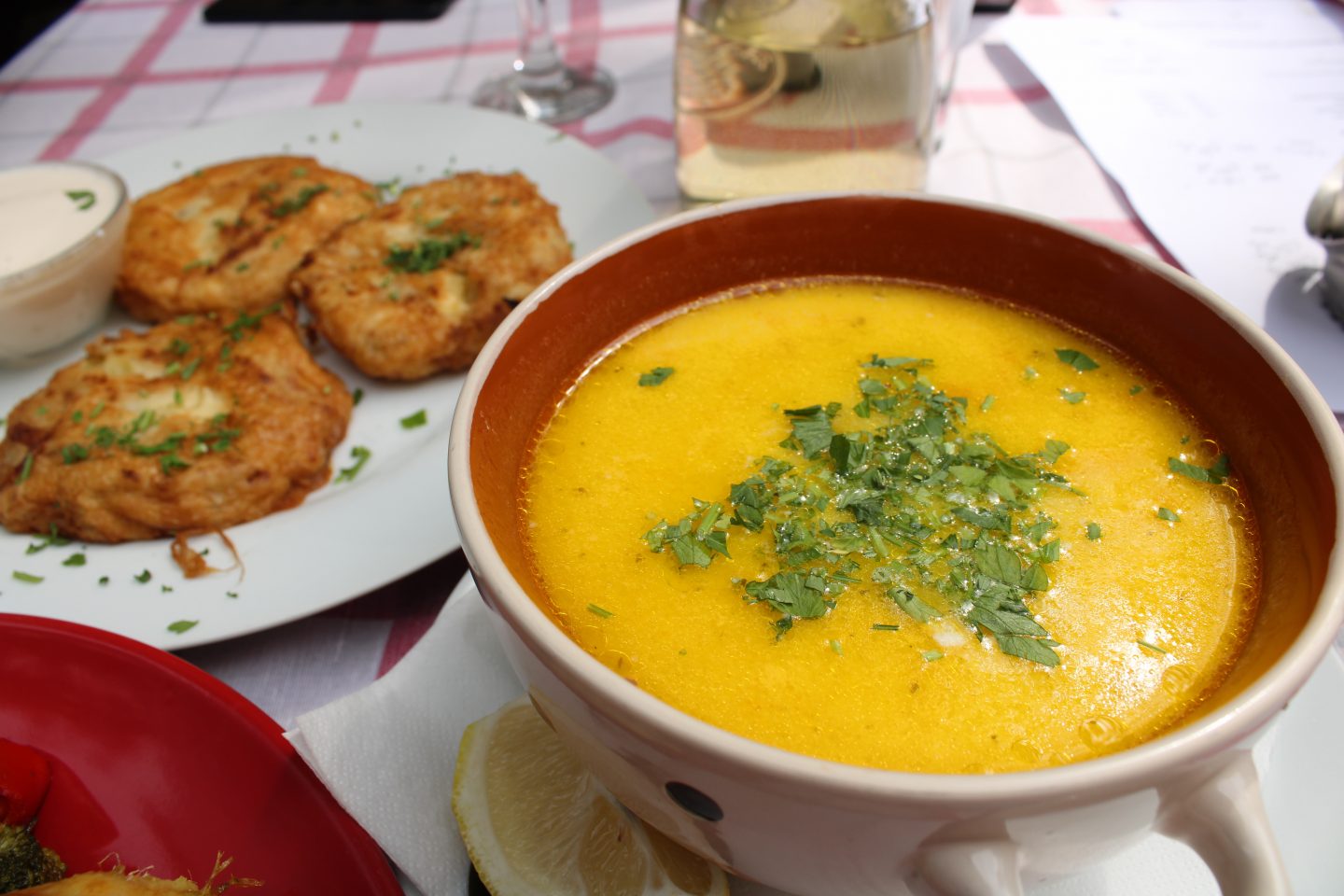
Snacks and Starters in Traditional Bulgarian Cuisine
Shopska Salata
I mentioned above that it’s common to begin a meal with a salad, and the most popular traditional Bulgarian salad is the Shopska salata. This is a chopped vegetable salad of tomato, cucumber, onion and pepper, which is topped with Sirene – a white cheese unique to Bulgaria on the account of the microorganism that it’s made from, which can’t be found anywhere else and is such named ‘Lactobacillus bulgaricus’.
Interestingly, the three main colours of the salad (red tomatoes, green cucumber and white cheese) match the colours of the Bulgarian national flag! I wonder if this is a coincidence? Possibly not, as the dish is said to have been invented by the state tourism company, Balkan Tourist, during the Communist Era.
There are other popular salads in traditional Bulgarian cuisine too including the Ovcharska (Shepherds) salad, which is created by adding ham, mushroom and egg to the Shopska salad.
Tarator
Before trying this dish I was expecting to really dislike it, but it was incredibly refreshing, especially on a hot day. Tarator is a cold, yoghurt-based soup made with cucumbers, walnuts, dill, water and, of course, Bulgarian yoghurt.
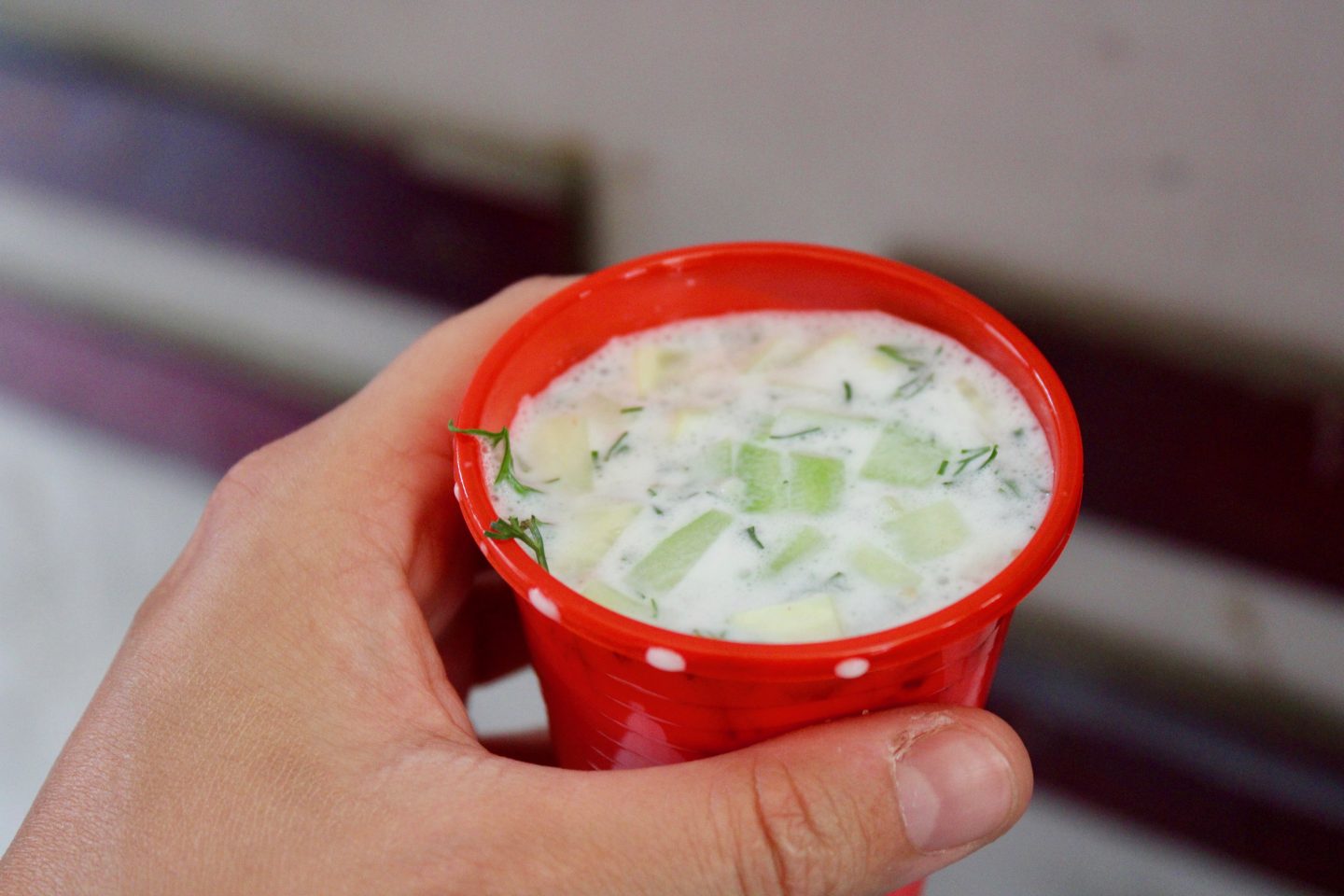
Tarator is often enjoyed as a snack or before a meal, and we enjoyed a taster of this on the free food tour, which took us to a 24 hour soup bar called Supa Star. If you like your soup, this is the place to go with a full menu of the stuff!
Shkembe chorba
I didn’t actually try this in Sofia, not because I was grossed out by the idea (if you’ve read my 30 must-try foods in Istanbul post you’ll know that I’m happy to try offal) but just because I didn’t get round to it. Shkembe chorba is tripe soup, and it’s commonly eaten not just in Bulgaria but across all of the Balkan countries.
The soup is made by boiling tripe for several hours, adding plenty of garlic and paprika (the more paprika the better!), and a little milk and oil. Bulgarians add vinegar, oil, salt and pepper before consuming, and it’s said to be the ultimate hangover cure!
Kurban chorba
Whilst we’re on the subject of soup, Kurban chorba is a hearty soup reserved for special occasions. As my weekend in Sofia didn’t quite qualify as a special occasion, I didn’t get to try any but I wanted to include it in this post as it sounds delicious!
Kurban chorba remains from Ottoman influence and its made from meat (usually lamb, mutton or veal), offal (usually liver) and vegetables including tomato, celery and onion.
Lyutenitsa
Somewhat tricky to both spell and pronounce, Lyutenitsa is a bright red relish that’s usually spread on top of bread and eaten as a snack. It’s made from tomatoes, red peppers, onion, garlic and cumin and it’s beautifully rich in flavour. As well as being consumed on bread, it’s sometimes served alongside a meat dish such as mixed grill or meatballs.
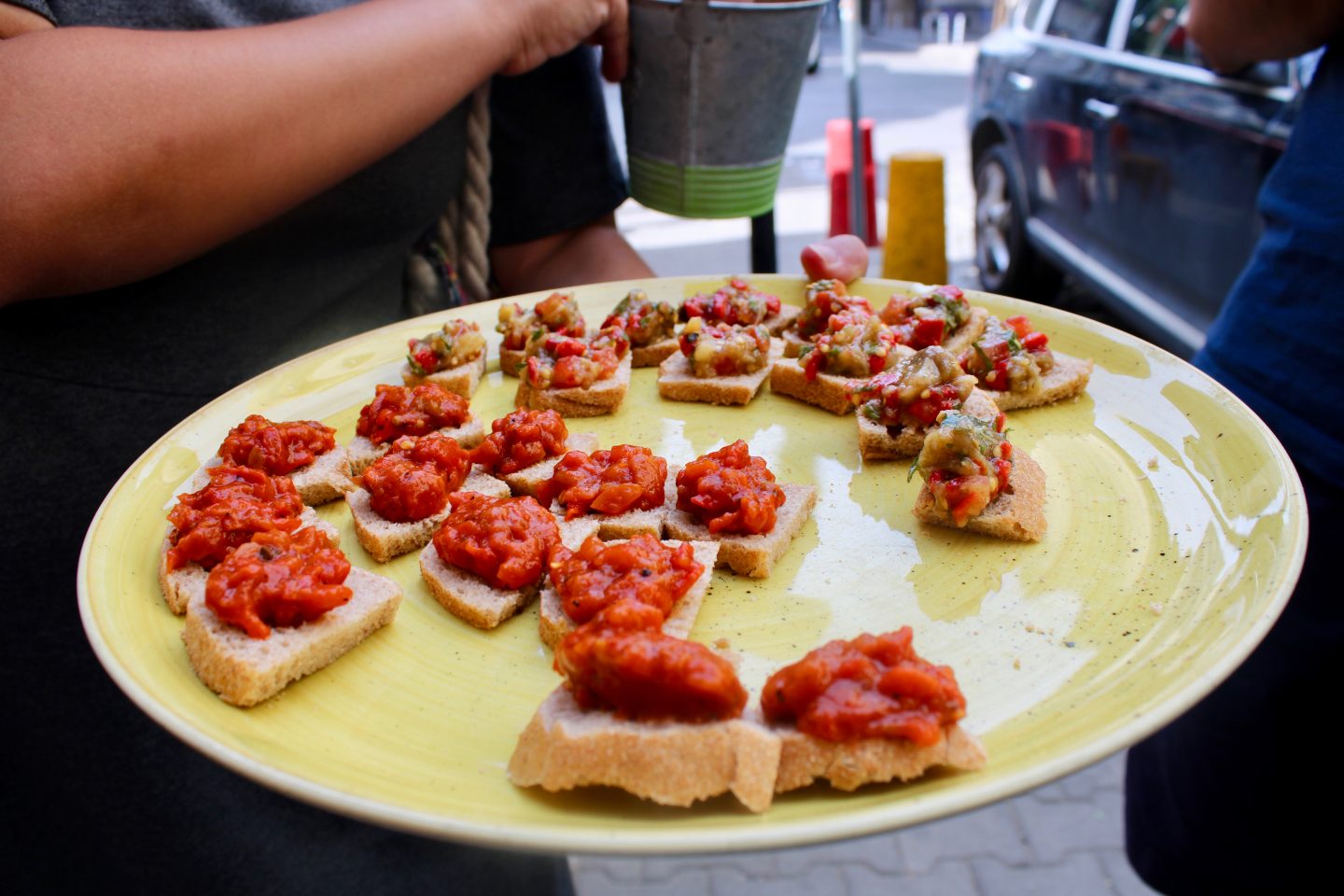
Turshia
Turshia is pickled veg, and after trying a range of pickled items a few days beforehand in Istanbul, I opted to avoid this at all costs! However, Turshia is a decidedly useful food as traditionally it was consumed as a snack during winter when was it impossible to get hold of fresh produce.
It’s usually a mixture of vegetables and you’ll find the likes of cauliflower, beetroot, carrot, aubergine, cabbage and peppers in there along with garlic and chilli.
Lukanka
Cured meat is one of my favourite foods, especially served alongside a nice glass of local wine! There are many cured meats traditional to Bulgaria, but the most popular is Lukanka. It’s made from pork and beef meat, seasoned with spices and traditionally stuffed in a dried cow’s intestine. Whilst it dries (over several weeks), a thin white mould forms on top of the casing which adds to its flavour.
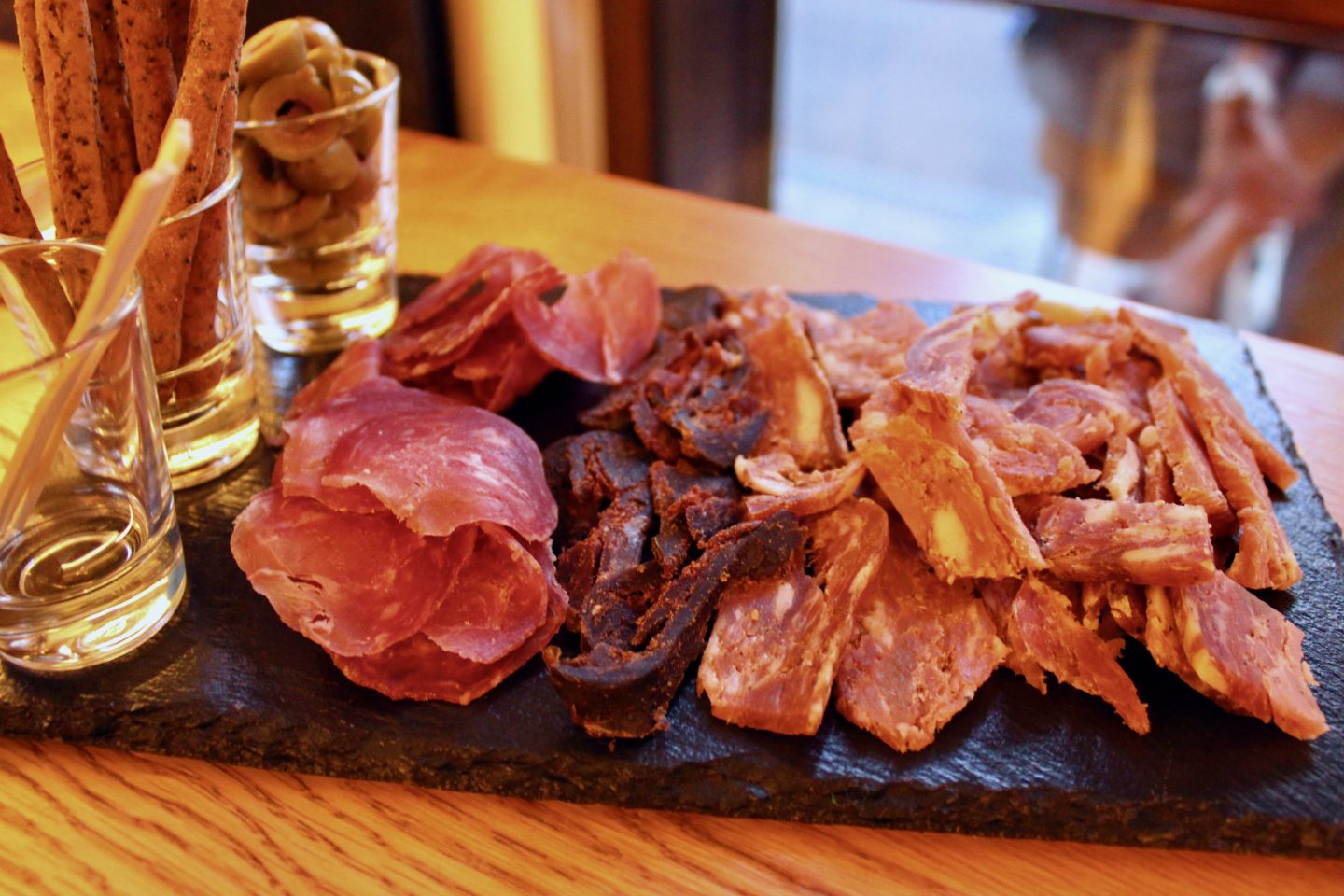
Traditional Main Courses in Bulgarian Cuisine
Grilled Meat
You’ll find a lot of grilled meat when looking for traditional Bulgarian food in Sofia, which goes perfectly with a cold beer on a sunny afternoon. There are a few different ways of serving it including as sausages, meatballs or even as a whole animal after roasting on an open fire for many hours! However, these tend to be the most popular:
- Kebapche – this is a long, thin kebab of meat, usually a mix of pork and beef. Think of a very big sausage which has been flattened a little! I didn’t get to try this in Sofia, but I had something very similar in Belgrade in Serbia, which was one of the best things I’ve ever eaten.
- Meshana Skara (mixed grill plate) – the ultimate meat-lovers dish, a huge plate of meat, served with chips or grilled vegetables
- Shishche (skewered meat) – we had a delicious hanging skewer of mix meat, peppers, onions and mushrooms at a restaurant called Hadjidraganovite Izbi

Slow Cooked Dishes
Hearty stews are a common traditional Bulgarian food found in Sofia and across the region, and are usually cooked and/or served in a clay pot called a Gyuvech. The pots are often passed down generations within a family or gifted at weddings. I tried a delicious slow cooked meat dish at the restaurant I’ve mentioned above, Hadjidraganovite Izbi. Here are a few different types:
- Gyuvech – this shares it’s name with the clay pot that it’s cooked in and usually contains beef, mushrooms, pepper and onion. A vegetarian version would contain things like aubergine, potato, courgette, carrot and tomato.
- Kavarma – this is usually cooked in a frying pan rather than a clay pot, but it’s then served in the clay pot. Again it will involve meat, onions, peppers and spices.
- Kapama – a favourite for meat-eaters, as you’ll find a mix of meat in here such as pork, lamb, rabbit, veal and sausage, alongside sauerkraut and dried plums for a bit of sweetness
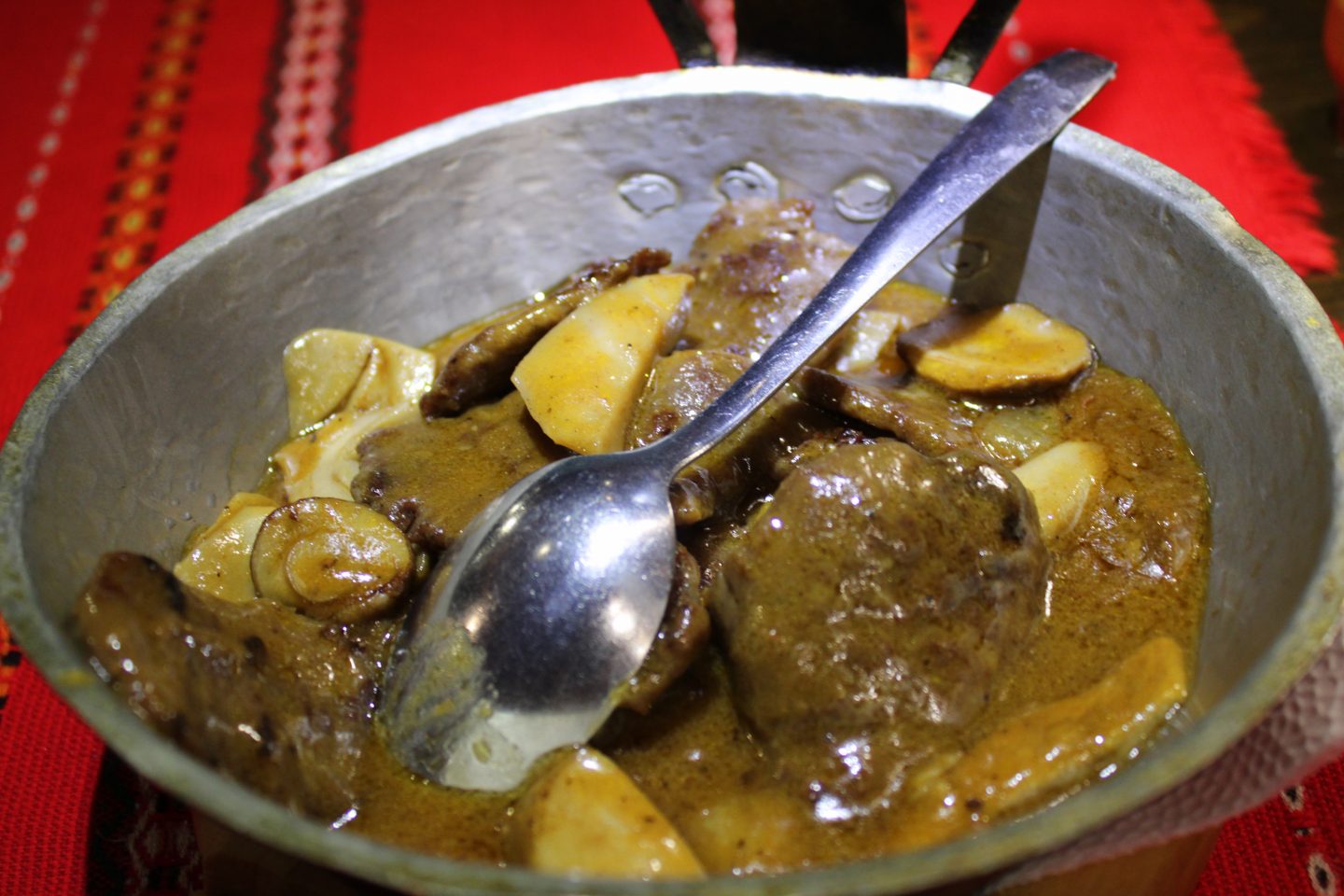
Bulgarian Musaka
I don’t know about you, but I love a moussaka! This traditional Bulgarian food is similar to the Greek version but is made with potatoes rather than aubergines, alongside eggs, yoghurt and minced pork. The eggs and yoghurt are often used as a topping, which forms a sort of rind when baked. It’s a well-known joke amongst Bulgarian men that they can’t marry a woman who’s unable to cook the perfect musaka.
Sarmi
Sarmi is another traditional Bulgarian food that I tried in Sofia, and loved! It’s vine or cabbage leaves stuffed with minced meat and rice, flavoured with paprika (of course) and boiled. Sarmi is usually consumed as a comfort food during the winter, and a vegetarian version is traditionally eaten on Christmas eve.
Byurek peppers
Anything with cheese is a winner in my mind, so I loved this dish. Byurek peppers are bell peppers stuffed with white cheese, breadcrumbed and fried. Absolutely delicious as a snack, or as main course served with salad and an egg!
Bread and Pastries
I’m all about the carbs, so this section is my favourite. Bread has a special place in traditional Bulgarian cuisine, and you’re unlikely to eat a meal without being served bread in some form. There’s even a saying in Bulgaria that ‘nobody is bigger than bread’. There’s a fair amount of symbolism connected to bread in Bulgarian tradition, for example it symbolises order, as opposed to chaos, because it represents so many different processes, from the wheat itself to the kneading and baking.
Bread also represents the fire that it traditionally depended on for baking, and it was believed that bread took on the power and strength of the fire and passed it on to those eating it, as well as cleansing the soul. Bread related rituals go back to Thracian times, and it’s symbolic of the beginning and end of life, with the word for ‘knead’ also meaning ‘to give birth’ in old Thracian language.
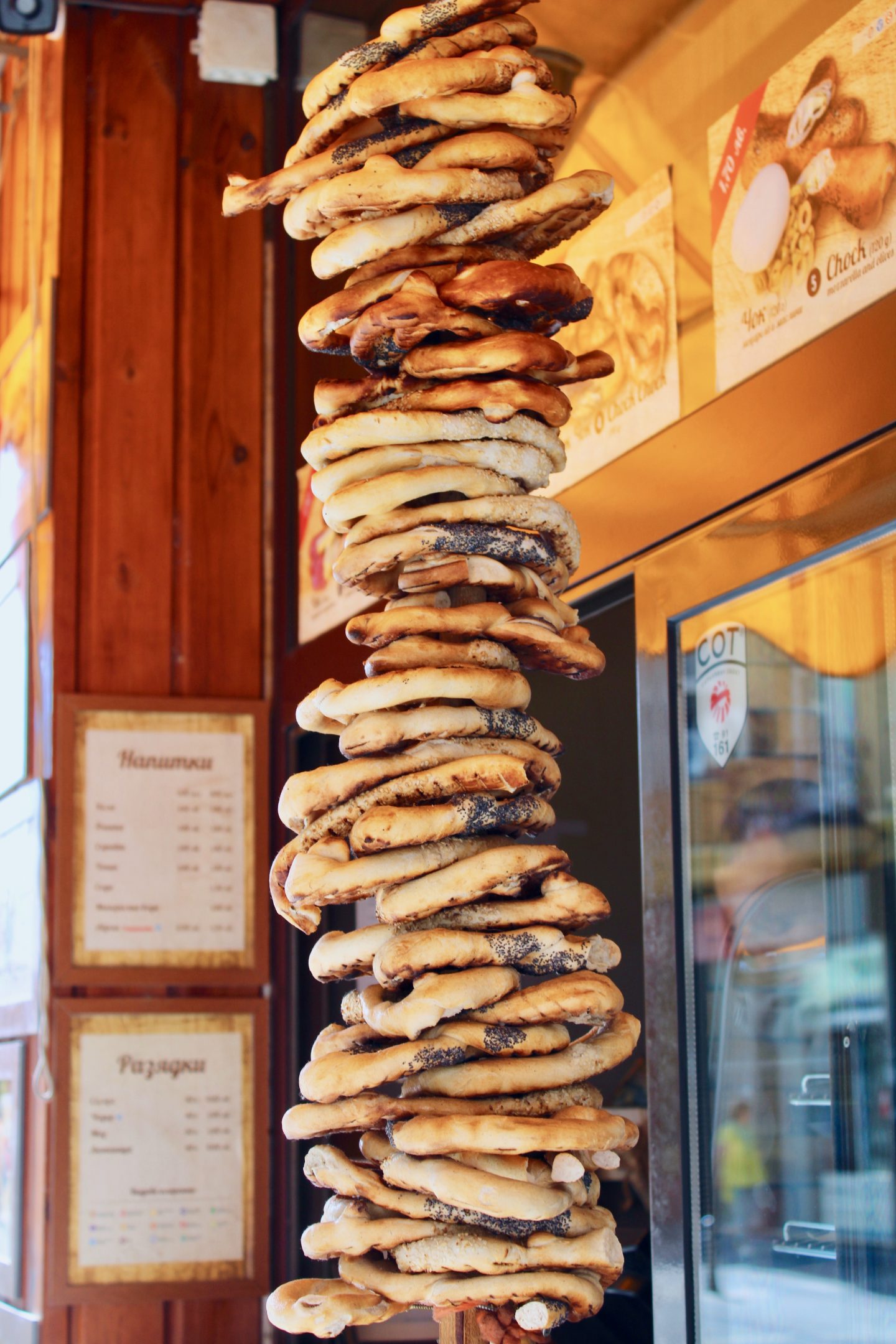
Because of this, there are many bread-related superstitions in Bulgarian tradition. For example, throwing away bread is considered a sin and bad luck, any bread that falls on the group should be kissed before its thrown away, bread should never be eaten in bed, and it’s bad luck to cut bread from both ends.
You’ll find all sorts of bread in Sofia and Bulgaria including Pitka (a tear-and-share style bread made with honey and butter), flat bread, Mesenitza (cheese-filled bread) and Kozunak (a slightly sweet bread mixed with raisins, served at easter).
Banitsa
A pastry rather than a bread, and my favourite food that I had in Sofia! It’s a soft, flakey pastry made with many layers of filo pastry and a filling of cheese, eggs and yoghurt before being baked. The free food tour mentioned above took us to a tiny bakery located in an underpass for some freshly baked, still warm Banitsa.

We also stopped for coffee and Banitsa on our way to the bus station at the end of our weekend in Sofia, and found a beautiful little café serving modern versions of the Banitsa including a savoury version containing spinach, and a sweet version with pecans and honey. Unfortunately I didn’t make a note of the name!
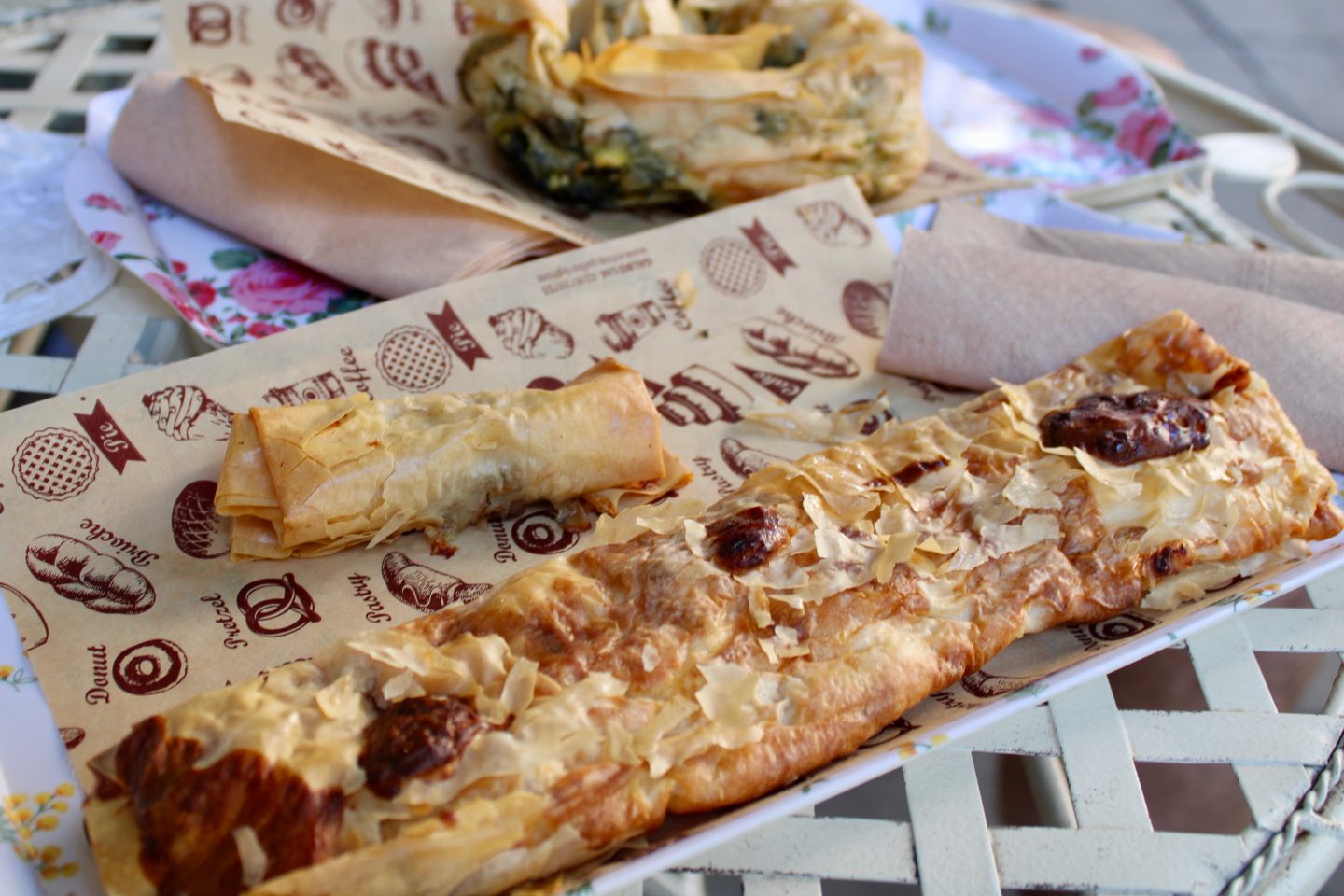
Mekitsi
Mekitsi is a common breakfast in Sofia, and it’s actually a staple breakfast in Bulgarian mountain huts too. It’s somewhere between pastry and bread, and it’s fried which results in something similar to a flat doughnut – but without the hole in the middle. It’s usually served with sugar or cheese, but there are endless toppings available in Sofia.
One of the most popular spots for fresh Mekitsi is Mekitsa and Coffee, and we enjoyed an indulgent breakfast of Mekitsi with Black Sea yellow cheese, then with spicy cheese, and finally with Nutella. All whilst watching the world go by from the window.
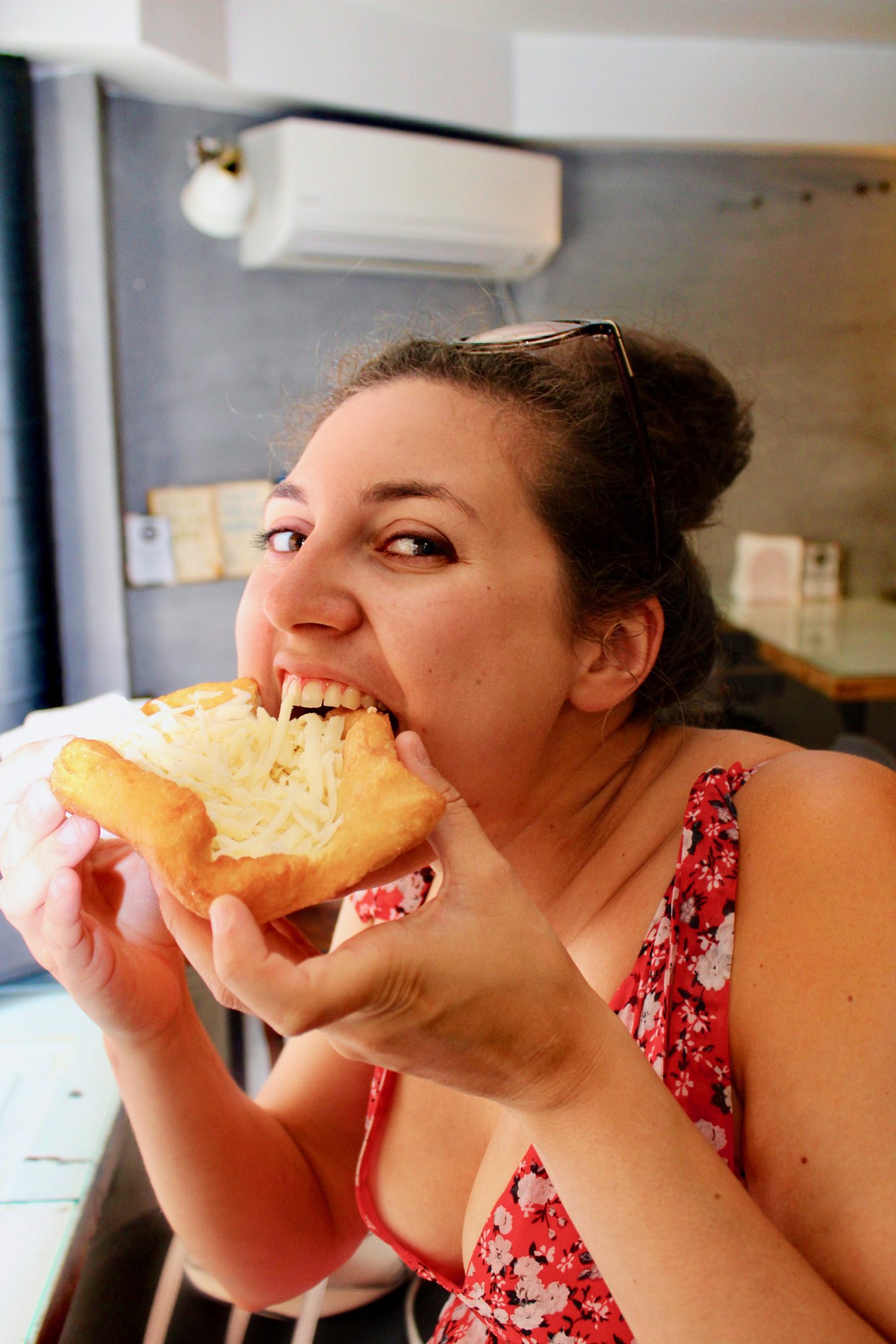
Bulgarian Drinks in Sofia
I won’t go into too much detail here, as the focus of this post is about food. However, I love a glass (or bottle!) of wine, and Bulgarian wine is surprisingly superb. So here are a few words about wine and other traditional Bulgarian drinks.
Wine in Sofia
I was pretty surprised to learn that back in the 1980s, Bulgaria was the 2nd largest wine producer in the world! I was also surprised to learn that Bulgaria is one of the oldest wine producers in the world – Bulgarian wine is even mentioned in the ancient Greek texts of Homer’s Illiad and Odyssey!
I mentioned at the start of this post that there’s evidence of wine producing in Bulgaria as early as 4,000 BC, and it’s true that when Bulgaria was inhabited by the Thracians they were famous for their wine-making skills.

This means that back when the Roman’s arrived in what is now Bulgaria back in the 1st century AD, there was already an established tradition of wine making. They encouraged wine-making further, and it’s been popular ever since!
We had some excellent wine in Sofia, and if you’d like to taste some of the local stuff I’d recommend visiting the below:
- Tempus Vini Wine Point – owned by a lovely man called Kalin Kyushev who left his pharmaceutical sales job to set up a wine bar and selects every bottle himself
- Garafa Wine Shop – offering 9 different wines straight from the barrel, all of which are of their own production at Tipchenitza Winery, located in Tipchenitza in the hilly northwest of Bulgaria
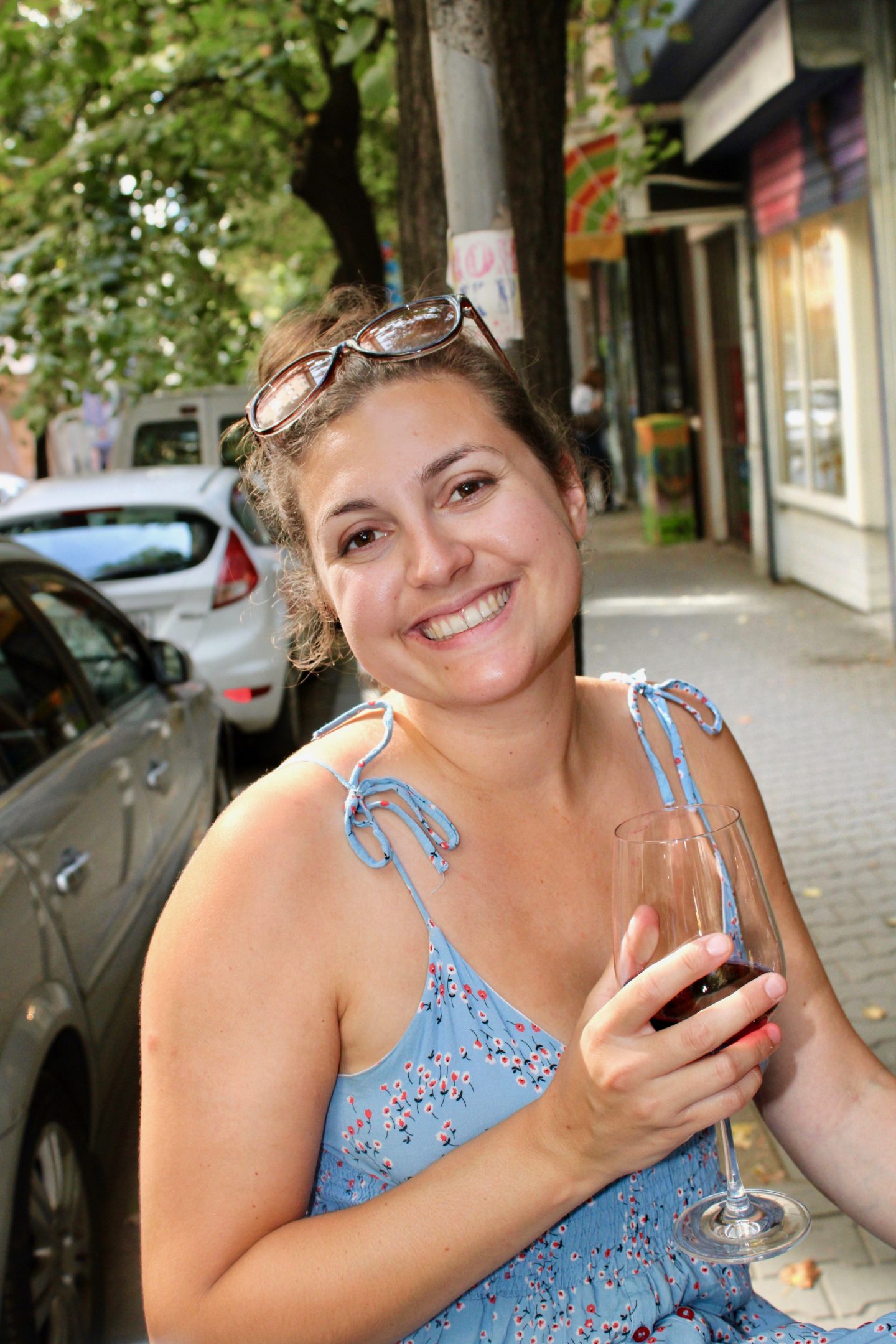
Whilst I love wine and almost all food, I’m very fussy when it comes to other drinks. I’ll therefore admit that whilst I tried all of the below drinks, I didn’t actually like any of them! However, they must be popular for a reason, so I’d still recommend that you give them a go.
Boza
This is a thick, sweet drink made from fermented cereal, usually millet. It either has a low alcohol content or contains no alcohol at all, and is served cold alongside pastries at breakfast.
Ayran
I’ve talked about Ayran in my post about Turkish food in Istanbul, and I didn’t like it there either! It’s a yoghurt drink made with yoghurt, water and salt and it usually consumed in the summer as a cold, refreshing drink.
Rakia
A drink that I kept getting offered in Sofia, as well as in other Balkan countries, but it just wasn’t to my taste. It’s a strong alcoholic drink, most similar to a fruit brandy. Depending on where you are in the Balkans the drink will vary, but the traditional Bulgarian version is usually made with grapes, plums and berries.
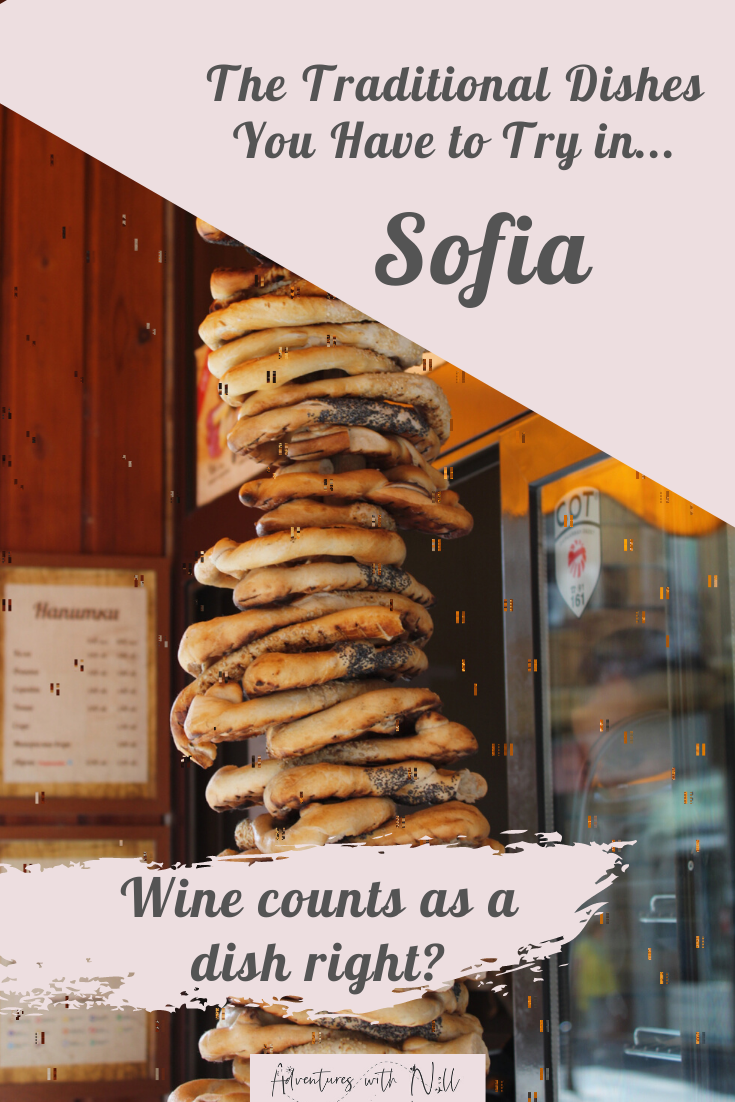
So there you have it! A pretty long guide to traditional Bulgarian food in Sofia. If you’d like to read more about Sofia, including some specific restaurant recommendations, take a look at my post ‘why Sofia is the perfect destination for a relaxing summer city break‘.
You may also want to explore the countries either side of Bulgaria, in which case these posts might be of interest:
- How to Experience Istanbul in a Weekend
- 30 Foods to Try in Istanbul
- Why You Should Take the Night Train From Istanbul to Sofia
- Istanbul to Venice by Train and Bus: a 17 Day Itinerary
Nell xx



